Imagine if we had a learning curriculum for modern knowledge work.
This curriculum would reliably produce elite performers, training them in the fundamental skills required to thrive in the digital age. It would impart concrete skills that could be generalized to any kind of knowledge work, not just one discipline or career path.
In our work at Forte Labs, we’ve worked with thousands of people from all over the world on improving their productivity using digital tools. We’ve noticed that people often adopt new tools to address challenges they’re facing at work. The shiny new thing introduces novelty that seems to help for a short time. But it soon becomes just another layer of complexity, exacerbating the original problem.
We’ve taken our learnings from the past few years, and especially what we’ve learned in our coaching program, to create the Digital Productivity Pyramid. It provides a framework for any stage of a knowledge worker’s learning journey, showing them where to focus next.
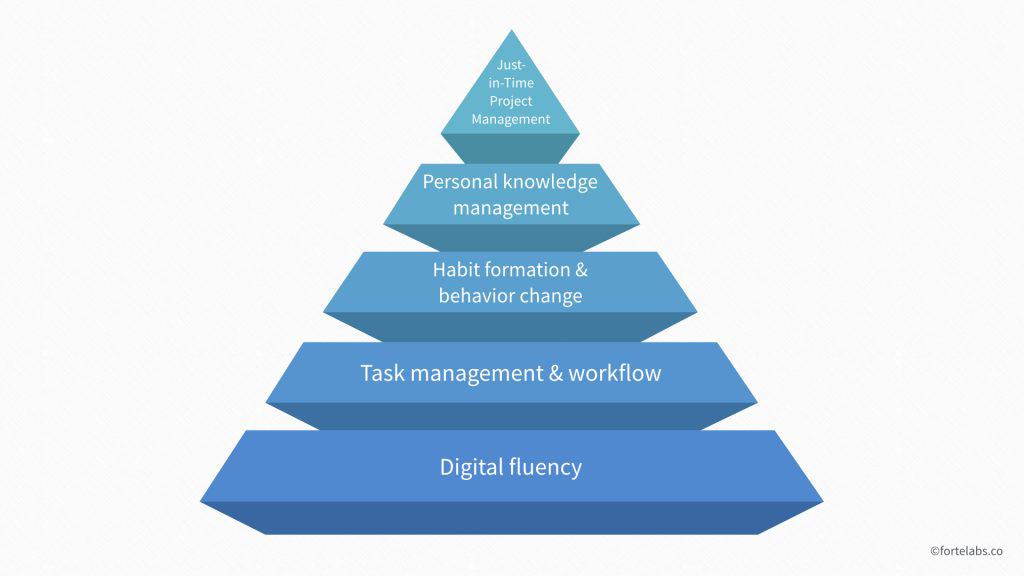
The Pyramid shows how higher-order productivity skills build upon and extend lower-order skills. It shows how each skill can be leveraged using a particular kind of digital technology, which is our focus.
Our hope is that this framework will guide anyone seeking to piece together the vast number of learning resources now available on new ways of working. It represents a learning curriculum based not on standardized testing or graduation requirements, but on the real demands of the 21st century economy.
Core Principles
1. Non-linear
The key breakthrough we needed to develop this model was that digital productivity is not a linear learning process. You don’t learn one skill at a time, in strict order, mastering one completely before moving on to the next.
It’s more like a spiral staircase, ascending through increasingly advanced versions of the same core skills. I would estimate that 90% of full-time knowledge workers are proficient in level 1, while less than 1% are proficient at level 5.
2. Skills + technologies
Each level of the Pyramid is a combination of human skills augmented or extended by some form of digital technology: hardware, software, or online platforms.
These skills range from very meta (noticing what you notice), to very actionable (using a text expander). Pairing each of them with a digital tool gives them scale and leverage.
3. Emergence
Each level emerges from the one below it, either extending or abstracting the same core principles. Each level also makes use of the time and attention freed up by the level below.
Building up each level involves an initial design/setup stage, during which key systems and habits are put in place, followed by a longer optimization/customization stage.
4. Information flows
The blocks within each level are ordered from left to right, not in chronological order, but in terms of which direction information flows. The actual behaviors involved with each skill may take place in any order, but are generally organized to process information from one state to another.
Here is the Pyramid with full detail. Let me briefly explain what each level means.

Level 1: Digital Fluency
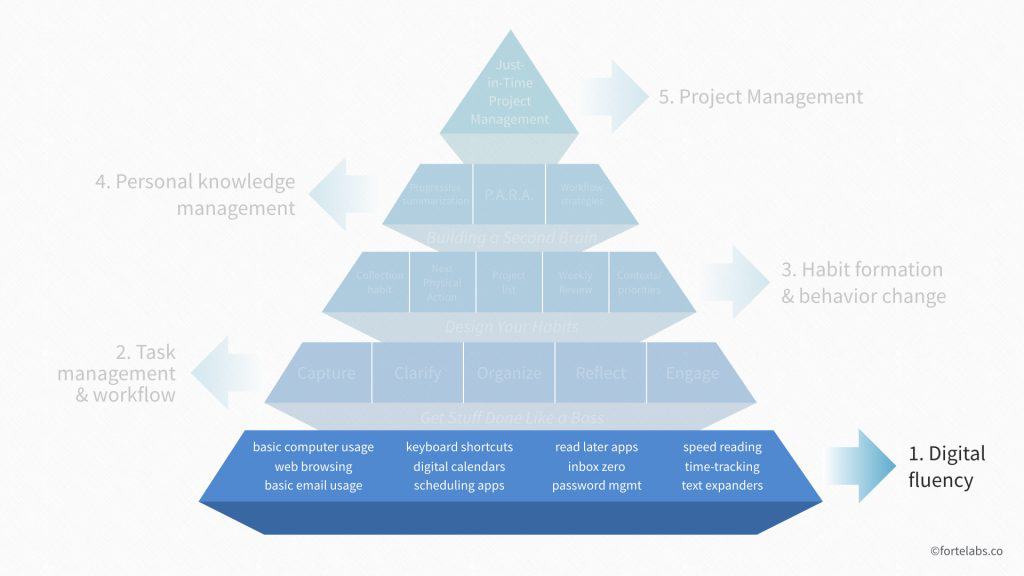
Includes:
- Basic computer usage
- Web browsing
- Basic email usage
- Keyboard shortcuts
- Digital calendars
- Scheduling apps
- Read Later apps
- Inbox Zero
- Password management
- Speed reading
- Time tracking
- Text Expanders
Digital literacy refers to the most basic familiarity with computers, such as how to visit a webpage or create a text document. Level 1 of the Digital Productivity Pyramid extends this concept to digital fluency.
Mastering computer skills is a learning process that never ends. Even the most advanced users continue to learn new keyboard shortcuts, discover new features of their devices, and optimize their settings.
We’ve placed these core capabilities at the bottom of the Pyramid because everything else depends on them
- Focusing on your actionable tasks (Level 2) will involve a lot of friction if you don’t have a dedicated place for reading online articles (Level 1)
- Building routines (Level 3) will be very challenging without a reliable digital calendar (Level 1)
- You’ll have trouble finding the time to organize your files (Level 4) if your email inbox is out of control (Level 1)
Gaps in high-level performance can often be traced back to weaknesses in these core capabilities. Small bits of friction at lower levels can add up to major frustrations when trying to excel at higher levels.
Focusing on Level 1 skills will strengthen all the levels above it, which is why our coaching program starts here. This might include building a solid morning routine (Level 3), redesigning your Weekly Review (Level 2), or setting up a text expander or password manager (Level 1).
Relevant Praxis articles:
- The Secret Power of ‘Read It Later’ Apps
- Case Study: Alex Hardy’s Successful Quest to Conquer Inbox Zero
Level 2: Task Management and Workflow
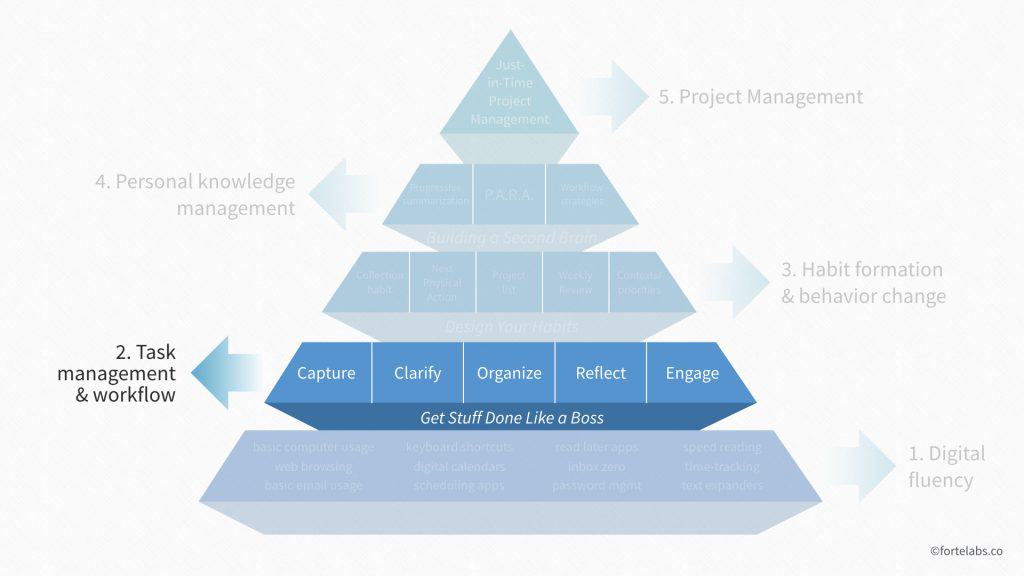
Includes:
- Capture: collect what has your attention
- Clarify: decide what it means
- Organize: put it where it belongs
- Reflect: review what you’ve collected
- Engage: take action
Task management is essentially “advanced to-do lists.” Popular digital task managers include Omnifocus, Things, Wunderlist, Todoist, 2Do, and Toodledo.
A workflow is simply the sequence of steps you move through to manage information using a task manager, from first identifying a potential action, to completion.
Although there are many ways to create a task management workflow, there is one that stands above the rest: David Allen’s Getting Things Done (GTD) method. The five stages of GTD are so fundamental to how actionable information is captured and managed to completion that we’ve used them to label this level:
- Incomplete capturing (i.e. writing down) of your tasks will absolutely become a bottleneck to any ambitious project you want to take on, as decisions and commitments get lost
- Trying to complete tasks that haven’t been properly clarified (i.e. formulated in a way that makes them actionable and outcome-oriented) is difficult and frustrating, since it won’t be clear why you’re doing them
- The most comprehensive collection of potential tasks is useless if not organized in a way that they can be quickly identified and acted on
- Strategic decision making depends on dedicated reflection time, to make sense of all the information being collected
- And of course, all of these tasks amount to excessive record-keeping if not actually engaged with and acted on
Relevant Praxis articles:
- The Annual Review is a Rearchitecture
- The Monthly Review is a Systems Check
- The Weekly Review is an Operating System
- One-Touch to Inbox Zero
- A Conversation with David Allen on Quantifying Productivity
Level 3: Habit Formation and Behavior Change
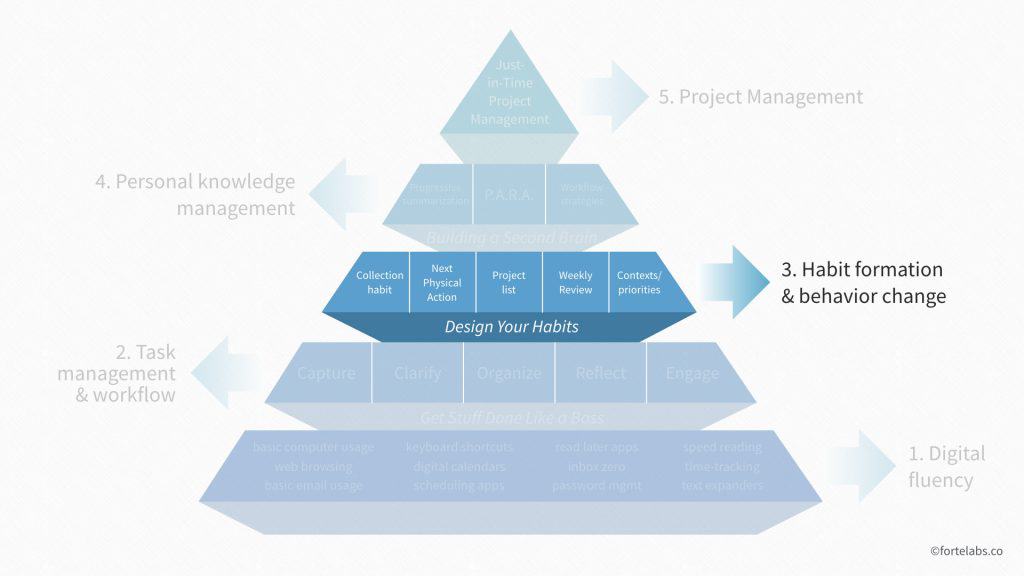
After an initial setup period, each one of the five principles from Level 2 must be put on autopilot to have their full impact. The key is to adopt a critical, automatic habit for each one:
- Capture => Collection Habit
- Clarify => Next Physical Action
- Organize => Project List
- Reflect => Weekly Review
- Engage => Contexts/priorities
These habits allow the principles of task management to recede into the background, taking up less and less attention over time. By understanding the basic principles, we can find original, creative ways of customizing them to suit our individuals needs and preferences.
Level 3 includes not just forming new habits, but extinguishing or adjusting existing habits. This requires examining underlying personal narratives, incentives, and patterns thats drive our behavior, using psychological and design techniques to reimagine them.
Relevant Praxis articles:
- The Topology of Attention
- The Inner Game of Work: Focus, Desire, and Working Free
- The World Beyond Your Head: How Distraction Shapes Who We Are
- A Theory of Unlearning: Ecstasis, Anamnesis, Kenosis
- Experimental Habit Formation
- Meta-Skills, Macro-Laws, and the Power of Constraints
Level 4: Personal Knowledge Management (PKM)
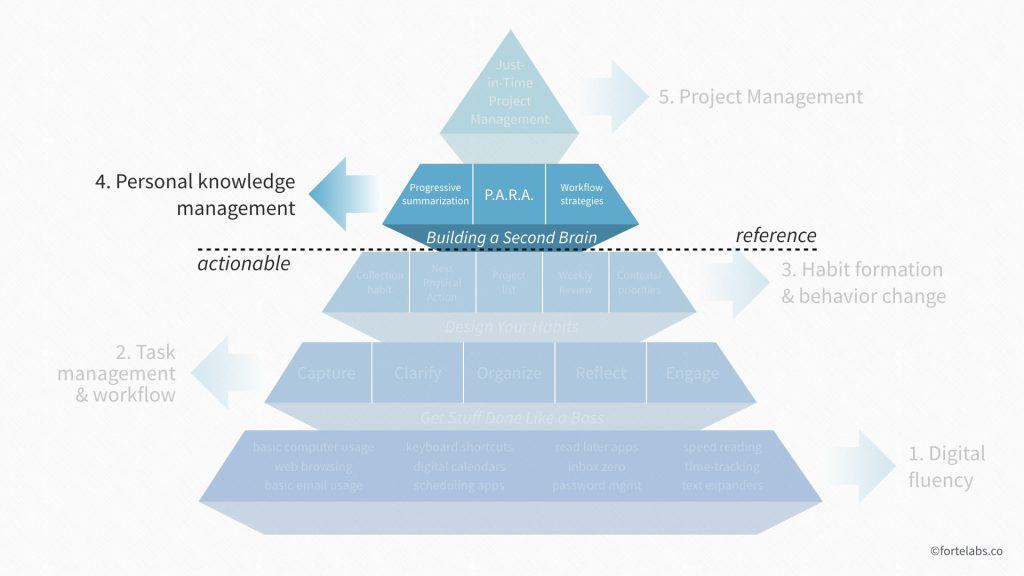
Includes:
- Progressive summarization
- P.A.R.A.
- Workflow Strategies
Whereas Level 2 is about taming the flow of information related to actions, Level 4 is about the flow of knowledge.
Personal knowledge management (PKM) is a set of skills and tools for an individual to capture, organize, and deploy the knowledge they accumulate while completing their work. It draws from diverse fields such as digital archiving, process management, and project management, and includes software programs for e-reading, digital note-taking, word processing, cloud storage, and others.
Personal knowledge management is the topic of Building a Second Brain, an online course in which we help people unlock their creative potential using digital note-taking software.
Relevant Praxis articles:
- Series on Progressive Summarization
- Series on the P.A.R.A. Method
- Masters of Creative Note-Taking: Luhmann and Da Vinci
- From Multitasking to Multiplexing: 5 Steps to Building a Personal Productivity Network
- Getting Things Done + Personal Knowledge Management
- How to Use Evernote for Your Creative Workflow
- Tagging is Broken
Case studies:
- Second Brain Case Study: Teaching Progressive Summarization in an Undergraduate Classroom
- Building a Second Brain in Emacs and Org-Mode
Level 5: Just-in-Time Project Management
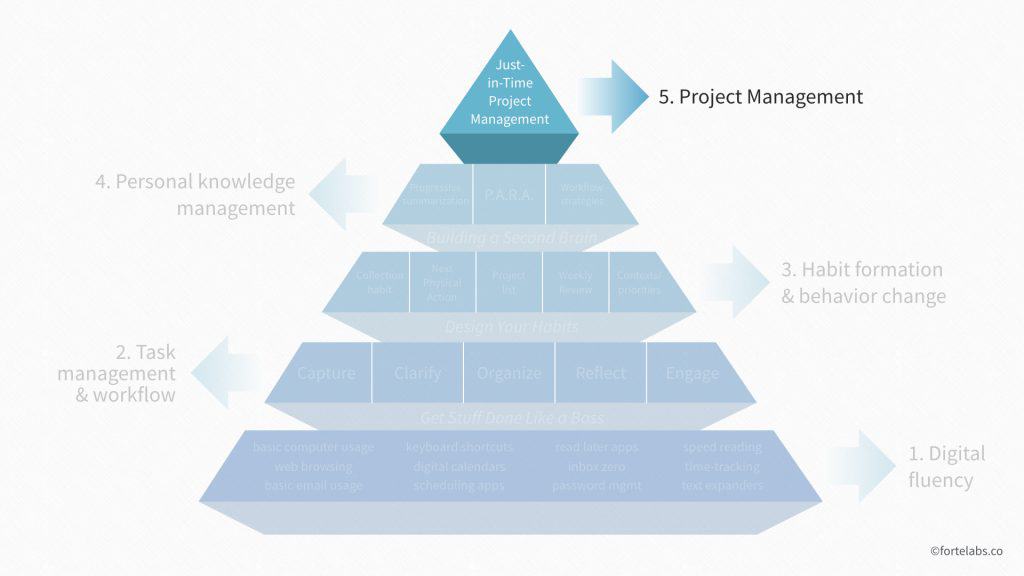
As working professionals, we don’t have time to consume a body of knowledge upfront and then regurgitate it for a test, as in school. Professional education has to take place right alongside daily work. We have to build the plane (and learn to fly it) as it’s taking off.
For PKM to be sustainable, it needs to directly enable the execution of real projects. That’s why Just-in-Time Project Management is the capstone of the Pyramid. The knowledge we are collecting and managing needs to have an immediate return to be justified, instead of only far in the future.
While you don’t need to build levels 1-4 before starting to work on real projects, the scale and ambition of the projects you can successfully execute is constrained by the structural integrity of your Pyramid. The taller the building you want to erect, the deeper and stronger your foundation must be.
Relevant Praxis articles:
- Series on Just-in-TIme Project Management
- Mood as Extrapolation Engine: Using Emotions to Generate Momentum
- Bending the Curves of Productivity
Case studies:
- How I Write Long-Form Blog Posts
- Riding the Writing Wave: How to Improve Your Writing, Get Rid of Writer’s Block, and Accelerate Your Output
- Personal Sprints: Applying Design Thinking to Your Life
- Second Brain Case Study: Researching and writing a 10,000-word academic article
The Next Frontier
We are hard at work on the next frontier – making Just-in-Time Project Management as coherent and teachable as the other topics. Read Tiago’s ongoing series on Just-In-Time Project Management for the latest developments.
In the meantime, we could really use your feedback and suggestions as we continue to refine and expand the Digital Productivity Pyramid. Comment below, in the Forte Labs Slack, or via email at [email protected].
Follow us for the latest updates and insights around productivity and Building a Second Brain on Twitter, Facebook, Instagram, LinkedIn, and YouTube. And if you're ready to start building your Second Brain, get the book and learn the proven method to organize your digital life and unlock your creative potential.
- POSTED IN: Education, Productivity, Technology
